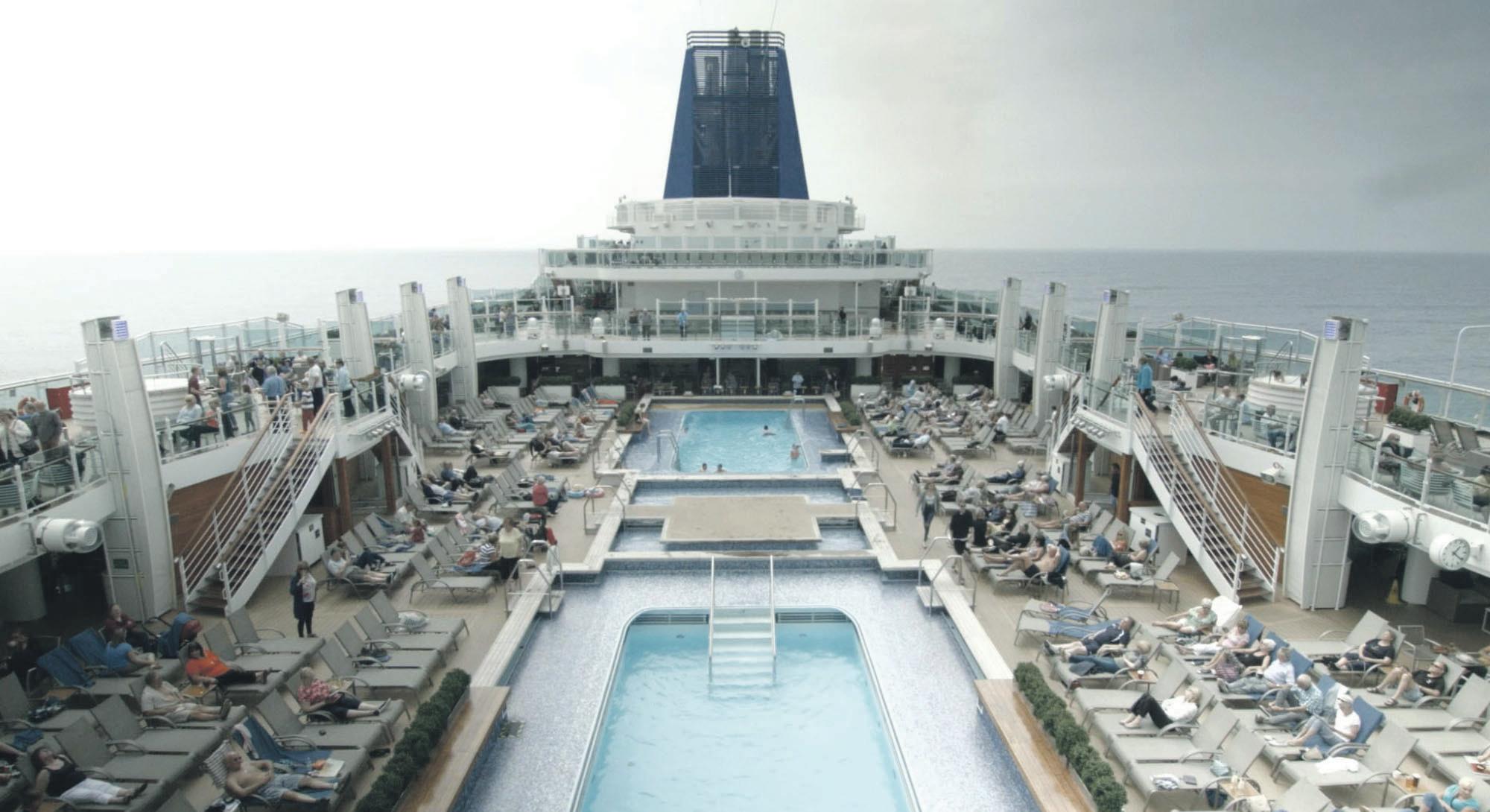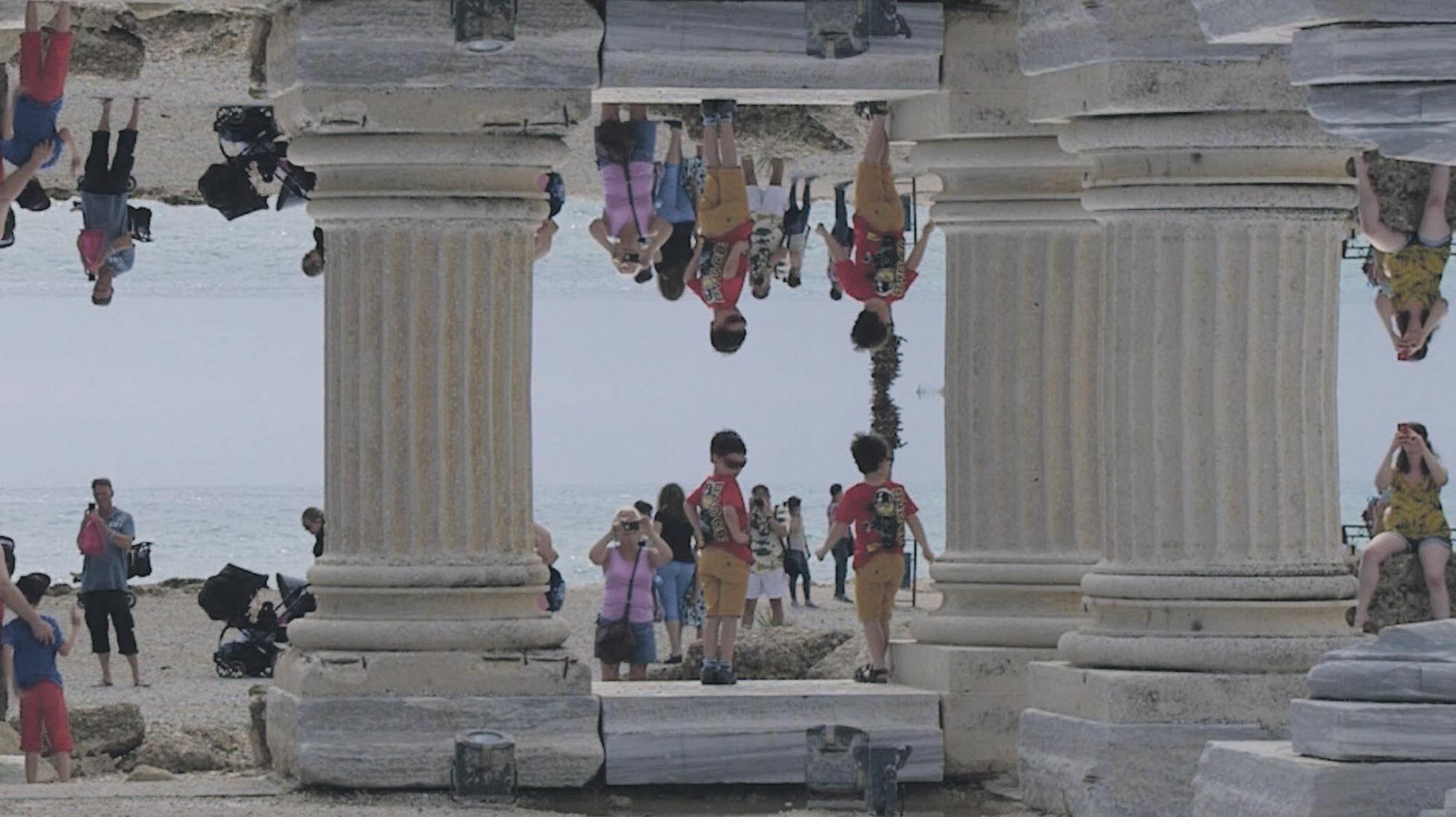
5 minute read
Sasha Litvintseva, Every Rupture (2020), Douglas Hyde Gallery
Sasha Litvintseva, Every Rupture Douglas Hyde Gallery 14 – 28 January 2021 Critique
“THERE’S SOMETHING ABOUT a mass-market Luxury Cruise that’s unbearably sad” explains the late David Foster Wallace during his weeklong sojourn onboard a cruise ship in A Supposedly Fun thing I’ll never do Again1. Wallace espouses his internalised despair, floating in an endless ocean in a world of luxury. This helpless desolation is equally drawn out in Sasha Litvintseva’s Every Rupture (2020), a film that seamlessly shifts across boundaries of geography and time, in a bid to process the events of the present pandemic moment and its politics. Shown as the eighth iteration of the Douglas Hyde Gallery’s online screening series and beginning and ending with a sigh – of acquiescence? Frustration? Despair? – the film is imbued with a weariness that lingers, aptly capturing the sense of a world at its wits’ end.
Divided into three parts, the film begins with a composite of video clips taken onboard a cruise ship, set against the backdrop of the UK’s exit from the European Union. A literal manifestation of this political event unfolds on screen as the cruise liner departs an EU port for Britain on the day of the Brexit referendum. Text at the bottom of the screen soundlessly narrates Litvintseva’s inner musings in tandem with the sounds of the ship and its occupants. As we watch spume lapping against the ship through the expertly lacquered wooden railings on deck, Litvintseva laments: “the celebration as the ship set sail away from Europe for me became a microcosm of a country unmoored.” This segment could also be described as a visual illustration of Wallace’s essay, albeit embedded within a very different global climate. As the ship’s horn blows at the beginning of the film, I hear it through his words; as a “shattering, flatulence-of-the-gods-like sound.”
In the second segment, the film takes us to an ancient forest in Lithuania, where a displaced colony of aquatic birds called cormorants have unhabitually taken up residence. We hear an arsenal of squawking, cawing, croaking and shrieking, gradually increase to raucous levels amidst treetops, fallen trees and scattered nests. Litvintseva discloses the damaging ecological effects of this rogue occupancy – the acidity of their excrement kills the trees they live in. Gradually, the trees die and they re-nest, “exponentially expanding decay in concentric circles.” With references to Brexit and Litvintseva’s own feelings of ‘heartbreak’ at that prospect still lingering, it doesn’t take long to consciously make the link that the artist may be comparing a species unwittingly shitting on its own home with a nation that voted for Brexit. The damaging effects of which are made manifest in this viscerally effective deployment of simile, while simultaneously juxtaposing political upheaval with ecological decline.
The final segment alludes to this historical moment – the pandemic – embedded within the setting of another. Amidst roman columns, perhaps a nod to the beginning of civilisation, we see sun-kissed tourists pose for photos, while children play. Grainy close-ups fill the screen of small hands mauling and climbing the remnants of another epoch in “a world where we touched things without fear.” As the film’s denouement reveals itself, the images become more fragmentary, referring back to the ‘closed systems’ of the cruise ship, the cormorants self-destructive rehoming and the tourist destination of a different time and space. Litvintseva interweaves these global events and ecological concerns with a lyrical and personal description of her lamentations as she mourns “the non-arrival of a new world.” A circuitous framework threads the film together with mirrored images like an inverted double-vision; Jacuzzi occupants appear rightside-up below and upside-down above, columns morph into themselves, silhouetted cormorant-filled trees float in the centre of the screen like black filigree. Litvintseva draws our attention to the ship’s water circulation, describing its cyclical re-use: “a taste of sewer water on my toothbrush, a testament to the impossibility of a closed system.”
Like Wallace’s despair aboard the luxury cruise liner, the film’s air of being helplessly lost in the empty immensity we find ourselves floating in, is palpable. Describing the irony of the cruise holiday, Wallace explains “a vacation is a respite from unpleasantness, and since consciousness of death and decay are unpleasant, it may seem weird the ultimate American fantasy vacation involves being plunked down in an enormous primordial stew of death and decay.” More meditative and reflective than Wallace’s neurotic insights, Litvintseva’s despondency is caused by external rather than internal forces. Yet, beginning and ending in sites of tourism and thusly sites of ecological demise, these nomadic tendencies are the lynchpin linking these porous circuitous spaces and geographies.
In the closing scenes, the artist invokes that these ‘ruptures’ of spaces between the present and the past demand a new way of living; “a different world calls for different images” but presently remain the same as the old. As a cormorant flies above the treetops to the soundtrack of an operatic Aria that eventually skips, getting stuck in an endless loop, we are left with a demoralising rather than edifying image. Litvintseva unapologetically dives deep into the grievous times we find ourselves in, mourning the destructive effects of our personal and political actions. However, this fatalistic approach can have the same destructive effect on our psyche as the events she is bemoaning, particularly at the time of its screening at DHG, when morale was low and doom-mongering high.
Still from Sasha Litvintseva, Every Rupture, (2020), HD video, Duration: 13:00. Courtesy of the artist Douglas Hyde Gallery.
Gwen Burlington is a writer based between Wexford and London.
Notes:
¹David Foster Wallace, ‘Shipping Out: On the (Nearly Lethal) Comforts of a Luxury Cruise’, Harper’s Magazine, January 1996, pp 33-56; republished in Wallace, A Supposedly Fun Thing I’ll Never Do Again: Essays and Arguments, (New York: Little, Brown and Company, 1997).












